

Site Search
Search within product
第727号 2021(R03) .01発行
Click here for PDF version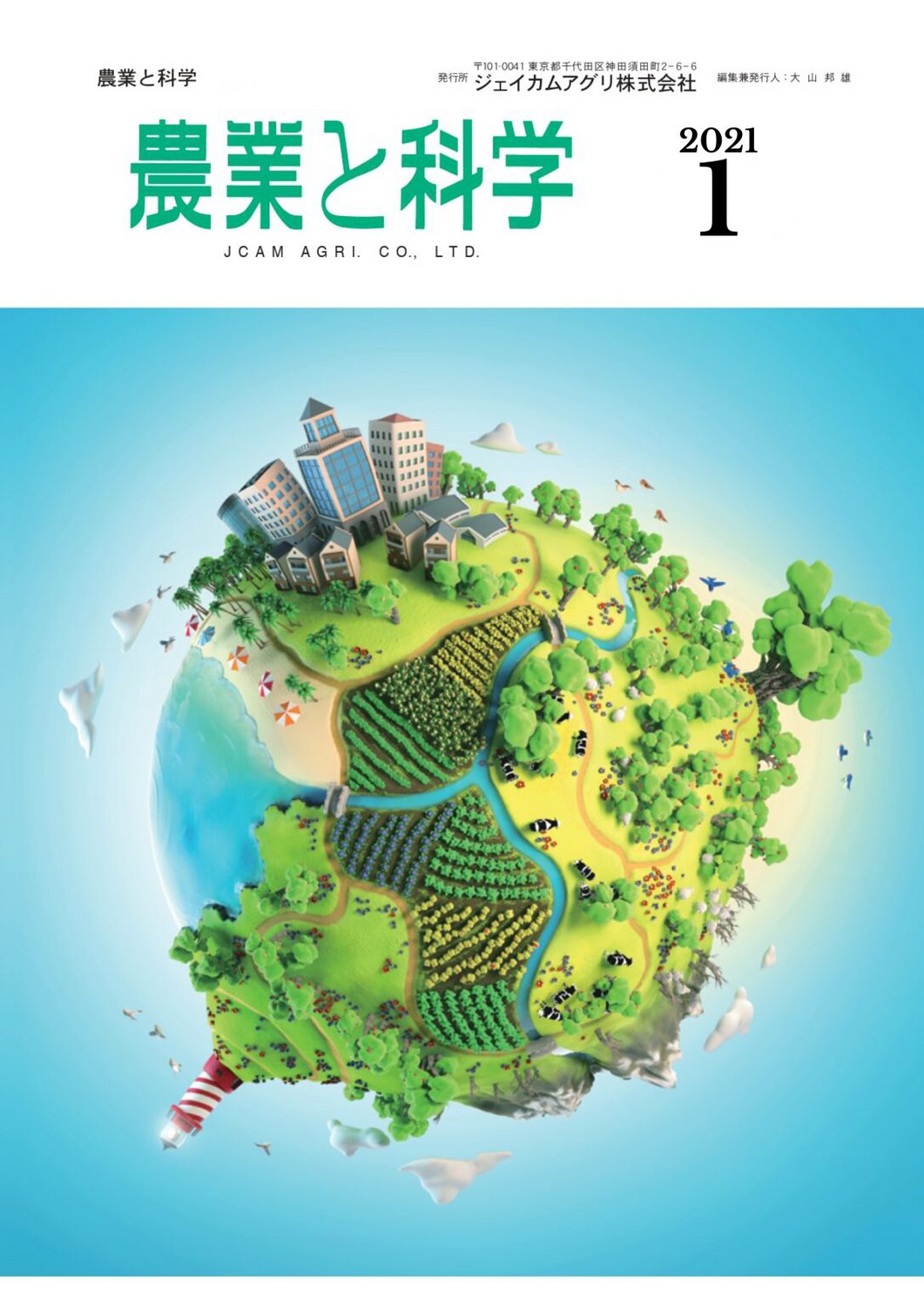
農業と科学 2021/01

本号の内容
§「更なる新しい常態」の創造に向けて
Jcam Agri Co.
営業統括本部長 田代 教昭
§春まきタマネギ栽培における肥効調節型肥料の利用
Fukushima Prefectural Agricultural Center
Vegetable Department, Crops and Horticulture Division
副主任研究員 横田 祐未
§行灯仕立てアサガオ鉢の購入後施肥方法と
長尺仕立てアサガオポット苗による新たな植物装飾の提案
東京都農林総合研究センター 江戸川分場
田旗 裕也
Toward the Creation of a "New Normal
Jcam Agri Co.
営業統括本部長 田代 教昭

Happy New Year!
令和3年の年頭にあたり,本誌「農業と科学」をご愛読いただいております皆様のご多幸とご繁栄をお祈り申し上げます。
Last year, the worldwide spread of the new coronavirus had a major impact on our lives. New lifestyles such as avoiding the "three densities," wearing masks, and disinfecting hands were introduced, as well as new work styles such as telework and remote conferencing.
In the agricultural sector, the decrease in demand for agricultural and livestock products for restaurants and the shortage of foreign workers have had a variety of effects, and various measures are being taken by individual producers, local communities, and the national government. With no end in sight, new initiatives such as "With Corona" and "After Corona" will be necessary in the future.
In 1981, our "LP Coat" was first shipped to Ishikawa Prefecture as a raw material for BB fertilizer (for additional fertilizer), and the following year, in 1982, our "LP Compound" made from "LP Coat" was shipped to Okayama Prefecture for direct seeding in dry paddy fields. This was truly the start of "whole paddy rice cultivation with basal fertilizer. Since then, we have continued to build up our technology with the support of our research and distribution partners, and have continued to do so up to the present day.
Today, "coated compound fertilizers" are produced and sold by various domestic fertilizer manufacturers, and they are now recognized as "one-shot fertilizers" in the agricultural industry. The percentage of rice paddy cultivation using these fertilizers is estimated to be more than 50% in terms of rice paddy area.
This is the so-called "new normal" in paddy rice cultivation.
However, with the recent intensification of weather fluctuations, changes in soil composition over the years, renewal of paddy rice varieties, and changes in demand from labor-saving to yield-increasing technologies, "paddy whole-plant fertilizer cultivation" is not always a "one-shot" solution.
It has been about 40 years since the "Total Rice Fertilizer Cultivation" started. Last year, we started to study the matching of "total fertilizer cultivation technology" and smart agriculture, although we are late to the game. We are committed to creating a "new normal" that can contribute to agriculture through fertilizers, with the goals of responding to climate change and meeting the demand for technology to increase yields.
In closing, I would like to wish you a Happy New Year and ask for your continued patronage of this issue of "Agriculture and Science".
Use of Fertilizer with Regulated Fertilizer in Spring Sown Onion Cultivation
Fukushima Prefectural Agricultural Center
Vegetable Department, Crops and Horticulture Division
副主任研究員 横田 祐未
Introduction
In areas in Fukushima Prefecture where evacuation orders have been lifted and in areas affected by the tsunami, there are few farmers who have returned to their farms, so a small number of people are required to manage large plots of land in order to maintain local agriculture. Land-use type open-air vegetables such as onions have been introduced to the region as a new crop to improve the profitability of management entities, and the onion cultivation area in the Hamadori region has expanded rapidly, starting from 30 a in FY 2015 to 2,742 a in FY 2020.
Onion cultivation in the prefecture is divided into two types: fall sowing, in which onions are sown in August or September and planted in October, and spring sowing, in which onions are sown in January and planted in March, with the harvest period from June to July. In spring sowing, the period from planting to harvest is about three months, and generally no additional fertilizer is needed in the field. However, in fields with low soil fertility, fertilizer runoff during the growing season can cause nitrogen deficiency, leading to poor growth and lower yields.
In this study, we selected a leaching type of controlled-release fertilizer suitable for spring-sown onion cultivation and attempted to determine whether a combination of conventional fertilizer and controlled-release fertilizer could produce the same yield as conventional fertilizer with a reduced basal fertilizer.
This test was conducted as a commissioned test for the Fukushima Plant Protection Association's "Test and Research Project on New Pesticides, etc.".
2. Testing Method
(1) Outline of cultivated species
The trials were conducted in open fields (gray lowland soil) at the Fukushima Prefectural Agricultural Center in Koriyama, Fukushima Prefecture, for two years, 2018 and 2019. The seedlings were sown in 448-hole cell trays on January 24, 2018 and January 18, 2019 in a glasshouse with one inner curtain, and the temperature was set so that the minimum temperature would not fall below 10°C. The number of emerged leaves was 2.5 to 3. Minoru Mega Soil (Minoru Sangyo Co., Ltd.) was used as the soil medium, and Tomy Liquid Fertilizer Black (Katakura Co-op Agri Co., Ltd.) was used as the fertilizer. Base fertilizer was applied on the day of planting.
Planting was done on March 31, 2018 and April 2, 2019 using a four-row fully automatic transplanter. The planting density was 26,667 plants/10a (4 rows planted per row, row width 120 cm, row spacing 20 cm, and plant spacing 10 cm). The date of downfall, when 80% of the plants had fallen over the ground, was July 4 and July 15 in 2018 and 2019, respectively. Harvesting was conducted simultaneously 7 days after the toppling date, on July 11 in 2018 and July 22 in 2019. Harvests were dried and stored in pipe houses covered with shading material with a shading rate of 501 TP3T.
2) Fertilizer selection (2018, 2019)
Since onion tuberization is initiated by long-day conditions, it is important to allow sufficient growth of the stem and leaves by then. In addition, it is necessary to consider the negative effects of insufficient nitrogen at the start of enlargement, which results in poor ball enlargement, and too much nitrogen, which delays enlargement and tends to produce rotten balls (Kato, 1963; Iwata, 1959). In spring-sown cultivation of "Momiji No. 3" in Koriyama, stem and leaf growth was vigorous from mid-May, and around June 22, the number of emerged leaves reached 12 and enlargement progressed (Figs. 1-3).
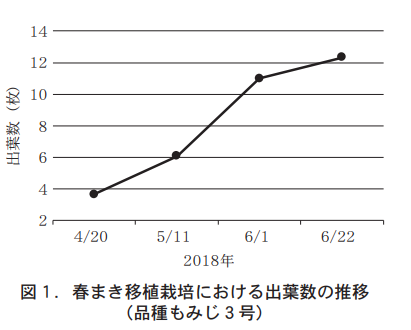
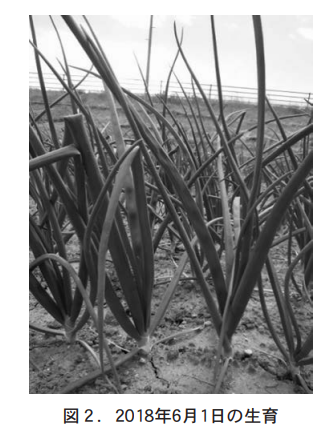

このようなタマネギの生育特性を考慮して肥大期に遅効きしないように,肥料は窒素の溶出調整が可能な被覆尿素肥料のエムコート(ジェイカムアグリ株式会社)を用い,春まきタマネギ栽培に有効な溶出期間,溶出タイプを把握するため,表1の試験区を設定した。溶出タイプは2018年はリニア型溶出のL20,リニア型溶出のL30,リニア型溶出のL40,シグモイド型溶出のS20H,シグモイド型溶出のS30Hの計5種を供試した。2019年はL30とS20Hを用いた。なお,対照として窒素肥料に燐硝安加里S604を用いた慣行区を設けた。各区の面積はそれぞれ6m2(1.2m×5m) ,3反復で実施した。
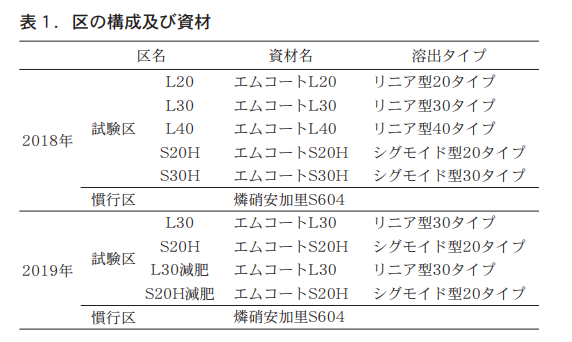
Fertilizer application rates for the test plots are shown in Table 2. Fertilizer was applied on the planting date. In the conventional zone, 15 kg of nitrogen, 30 kg of phosphate, and 15 kg of potash were applied per 10 a. In the other zone, half of the total nitrogen content was fertilized with a fertilizer with a controlled fertilizer. In the other areas, half of the total nitrogen was fertilized with a fertilizer with regulated fertilizer, and the other half with the conventional fertilizer, S604 phosphonitrite and potassium sulfate, together with 20% phosphorus and potassium sulfate, the amounts of fertilizer applied to the field were 15 kg of nitrogen, 30 kg of phosphoric acid, and 15 kg of potassium per 10 a.
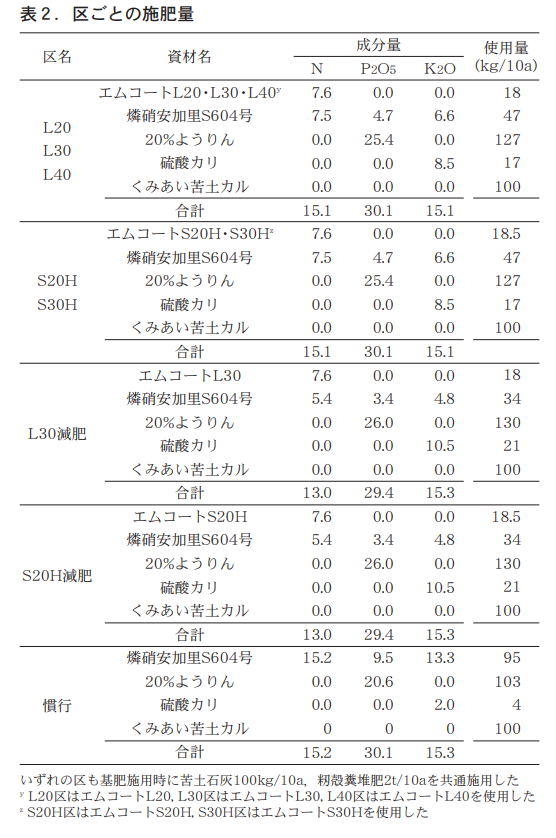
3) Investigation of the effect of fertilizer application regulating fertilizer on fertilizer reduction(2019)
Because of the high fertilizer efficiency of fertilizer application, the test plots in Table 2 were set up to confirm the effect of fertilizer reduction of S604 phosphonitrite and potassium phosphate, the conventional fertilizer used as the base fertilizer. L30 (linear elution) and S20H (sigmoidal elution) were used as elution types.
In the L30 reduced fertilizer and S20H reduced fertilizer test plots, half of the total nitrogen was fertilized with fertilizer with regulated fertilizer, and the conventional fertilizer, S604 phosphorus nitrate and potassium sulfate, was reduced by 30%, and the amount of fertilizer applied to the field together with 20% phosphorus and potassium sulfate was 13 kg for the nitrogen component, 30 kg for the phosphoric acid component and 15 kg for the potash component per 10 a. The fertilizer was applied in the main field.
(4) Survey Method
The integrated nitrogen leaching rate of the fertilizer was calculated by placing 2.5 g of each of the test fertilizers in mesh bags in the ground in each test plot about 5 cm from the soil surface on the planting date, and then placing the bags in the ground on April 20, May 11, June 1, and June 1, 2018 before harvest.
June 22, July 13 (5 times in total), and in 2019 on May 7, June 5, June 27, and July 11 (4 times in total), and the nitrogen residual was analyzed and calculated.
The soil temperature in the field was measured 5 cm below the ground surface using a data logger "Ondotori" (T&D Corporation). For the onion growth survey, grass height, leaf sheath stem, and number of emerged leaves were measured on 40 plants in each plot after fertilizer application. Grass height was
The length of the leaf sheath, which is the maximum length from the ground edge, was measured with a ruler. The leaf sheath stem was measured with a digital caliper at the short stem at the border between the leaf and the ball. Ball weight and ball diameter of the harvest were measured on July 27, 2018 and August 1, 2019, and rot incidence was measured on July 27 and August 27, 2018, and August 1 and August 19, 2019, for 40 plants per plot for the degree of rot progression from the leaf sheath area.
For temperature and precipitation, Amedas Koriyama site data were obtained (Japan Meteorological Agency, 2018-2019).
3. results
(1) Weather conditions
(1) Temperature and precipitation
Average temperatures in 2018 were 15°C from late April and reached 25°C in early July; average temperatures in 2019 were 15°C from early May and did not exceed 25°C until mid-July. Precipitation amounts were 60 mm in late April and 90 mm in early May 2018, with a significant amount of precipitation in early May (Fig. 4).
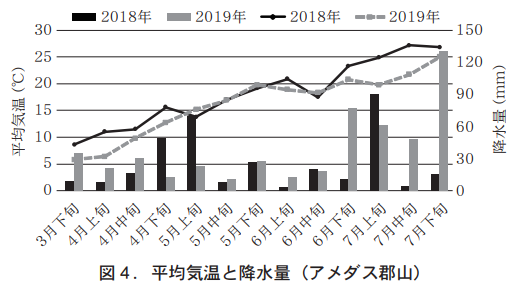
(2) Average soil temperature
In 2018, temperatures began to exceed 15°C from late April and the average soil temperature exceeded 25°C from early July onward; in 2019, temperatures began to exceed 15°C from early May and remained lower than in 2018 from late June onward (Figure 5).
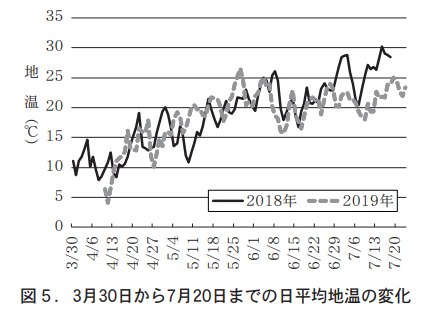
(2) Elution type suitable for spring sown onion cultivation
(1) Nitrogen integrated leaching rate of fertilizer with regulated fertilizer
L20, a linear em-coat (only in 2018), eluted linearly after application and reached 78% elution on May 11, when the integrated soil temperature after 52 days reached 751°C (theoretically 25°C x 20 days = 500°C) (Fig. 6). l30 eluted linearly after application in 2018, reaching 81% elution on June 1, when the integrated soil temperature after 62 days reached In 2019, it eluted 481 TP3T on May 7 and reached 801 TP3T elution on June 5, when the integrated soil temperature reached 1,079°C (theoretically 25°C x 30 days = 750°C) after elution (Figure 7).L40 (conducted only in 2018) eluted linearly after application and reached 75% elution on June 1, when the integrated soil temperature reached 958°C (theoretically 25°C x 40 days = 1,000°C) 62 days after application (Figure 6).
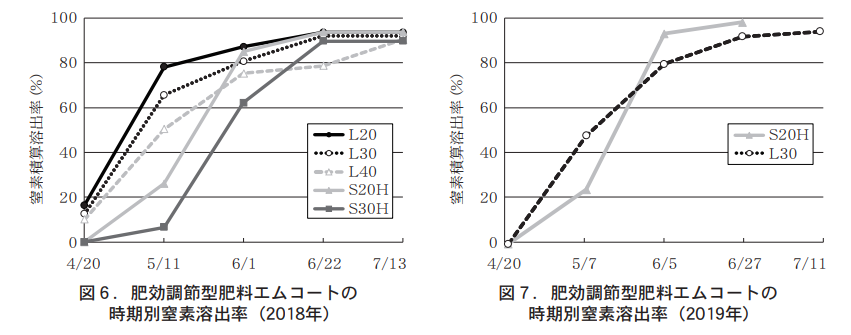
シグモイド型のエムコートであるS20Hは2018年は4月20日時点では溶出せず,5月中旬頃から溶出が始まり,溶出から積算地温で728℃(理論上は25℃×20日=500℃)となった6月1日に85%溶出に達した(図6) 。2019年は5月7日には24%溶出し,溶出から積算地温で630℃となった(理論上は25℃×20日=500℃)6月5日に93%溶出に達した(図7) 。S30H(2018年のみ実施)は5月11日時点では6.6%とほとんど溶出せず,6月1日に62%溶出となり,溶出から積算地温で682℃(理論上は25℃×30日=750℃)となった6月22日に90%溶出に達した(図6) 。
Based on these results, M-Coat L30, L40, and S20H were the desired elution types, eluting in May, when weather and soil conditions are assumed to make it easier for the base fertilizer effect to wear off, and eluting at 80% in early June.
2) Effect on onion growth
In 2018, grass height was minimum in the L40 section and maximum in the conventional section on May 11, but by June 1 there was no difference. No significant differences in number of leaves emerged and leaf sheath stems were observed throughout the period (Table 3). 2019 showed no significant differences in grass height, number of leaves emerged, and leaf sheath stems throughout the period in all sections (Table 4).
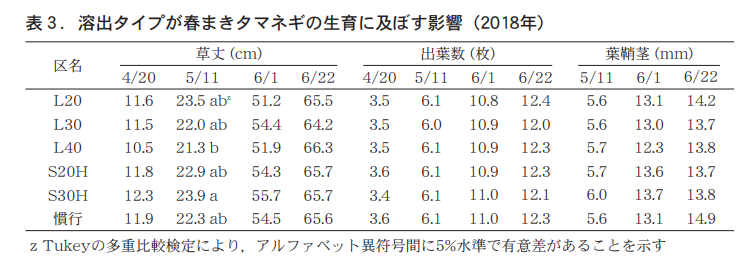
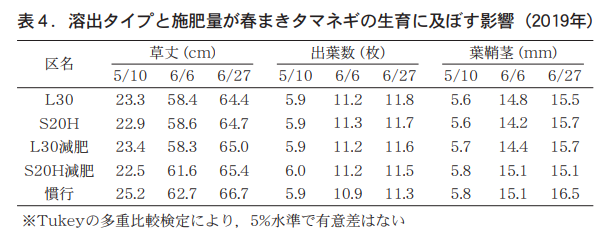
3) Impact on onion yield
No significant differences were observed in ball weight, ball diameter, standard ball percentage, outer partial ball percentage, and rot percentage at harvest and one month after harvest in all the sections in both 2018 and 2019. Within-specification yields ranged from 4.7 to 5.0 t/10a in 2018 and 6.1 to 6.5 t/10a in 2019 (Tables 5 and 6).

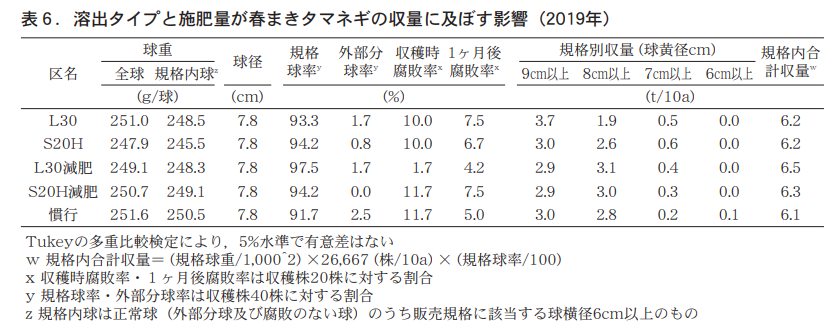
Consideration
The conventional fertilizer used in this study, phosphorus nitrate-ammonium potassium S604, is composed of approximately 60% ammonia nitrogen and 40% nitrate nitrogen, and ammonia nitrogen lasts for approximately one month, while nitrate nitrogen may be lost in a short period due to rainfall, but it is estimated to last for approximately 15 days. Therefore, it is assumed that the effect of basal fertilizer tends to wear off in May, and the fertilizer used in this study, Emcote, a controlled-release fertilizer, made it possible to stably supply nitrogen components in May, when the above-ground area increases, and there was no effect on yield or rot rate. This suggests that there was no excessive supply of nitrogen during the fertilization period.
Summary
The types that leached in May, when the base fertilizer effect is expected to be easily broken due to weather and soil conditions, and leached 80% in early June were Emcote L30, L40, and S20H. When the fertilizer M-Coat was used for half of the total nitrogen content of 15 kg/10a, and the conventional fertilizer S604 was used for the other half, there was no effect on growth and yield regardless of which leaching type of M-Coat was used. Furthermore, when the nitrogen content of conventional fertilizer was reduced by 30% and M-Coat L30 or S20H was used in combination with the conventional fertilizer, the yield was equivalent to that of the conventional fertilizer.
thanks
We thank Dr. Kasai, Deputy Chief Researcher, and Dr. Ishiguri, Researcher, Vegetable Science Department, Crops and Horticulture Division, Fukushima Prefectural Agricultural Research Center, for their cooperation in conducting this study. Dr. Miura, Director of the Production and Environment Department, reviewed the manuscript. We express our deepest gratitude.
References
●加藤 徹 1963.
タマネギの球の形成肥大および休眠に関する生理学的研究(第3報) .
高知大学農学部
●岩田 正利・森田 勇・本多 藤雄 1959.
窒素供給期間の差異がタマネギの生育・収量に及ぼす影響.東京大学農学部
●農業技術大系 野菜編 8−②タマネギ,アスパラガス.
(社) 農山漁村文化協会
●東北・北陸地域におけるタマネギの春まき栽培技術
技術解説編(農研機構東北農業研究センター)
How to apply fertilizer after purchase of the morning glory pots for lanterns and
長尺仕立てアサガオポット苗による新たな植物装飾の提案
東京都農林総合研究センター 江戸川分場
田旗 裕也
Introduction
The morning glory is an herbaceous vine that evokes the beauty of art and is a traditional Japanese horticultural flower1). Its design has been skillfully incorporated into Japanese paintings and crafts, and it was a strong candidate for the Tokyo 2020 Games emblem2,3). Morning glory flower competitions and fairs are held throughout Japan, but the Iriya Morning Glory Festival, held in Taito City for three days and nights from July 6 every year, is the most famous and large-scale event4). Around 1992, the Iriya Morning Glory Festival was crowded with more than one million visitors over the three days, and it is estimated that the number of pots sold reached 150,000. The majority of the pots sold were from Edogawa Ward in Tokyo, and Edogawa Ward is known as a rare producer of morning glory pots in Japan (Photos 1), 5 and 6).

The morning glory pots sold at the Iriya Morning Glory Festival are usually made into paper lanterns, with four different colors, or four large-flowered varieties of different colors and patterns, planted in one pot. This cultivation method was originally developed to meet the needs of consumers for more flower colors, but it is also an effective strategy that takes advantage of the short transportation distance to consumption areas of urban growers7). However, even in the form of face-to-face sales with customers, it cannot be said that they are supplying potted flowers that consumers are satisfied with. For example, growers and sellers are first and foremost concerned about "flowers always blooming at the morning glory market," so they provide little support, including in terms of quality control, after the purchase. Therefore, the author focused on the number of flowers per pot, which is considered an important quality factor for four-planting morning glories, and examined fertilizer management methods for morning glories that can be appreciated with good flowering after purchase.
On the other hand, postwar Japanese urban policy is said to have shifted from quantitative development to qualitative development aimed at creating comfort, beauty, and individuality8) . In recent years, urban planning has placed emphasis on landscaping and heat island countermeasures, and has promoted urban development that respects the unique townscapes and landscapes that cities have historically and traditionally cultivated, and is concerned with coloring and hues9,10). In the midst of these trends, the use of woody vines has expanded, mainly for wall greening, and the production of long vines that can be viewed immediately after installation has been commercialized11,12) . However, there is little knowledge on herbaceous vines, and because they are considered difficult to maintain and sustain, they are often excluded from the list of recommended plants both on the websites of local governments that support wall greening and by contractors who undertake the work.
Therefore, in order to expand the use of morning glories as plant ornaments utilizing their vines, regardless of the lantern style, we attempted to use combustible growing containers and soil for the production of long pots of seedlings with strings as inducements, taking into account further labor-saving measures such as disposal after the end of cultivation.
2. post-purchase fertilization method for lantern-shaped morning glory pots
(1) Materials and method of lantern making (common to Experiments 1 and 2)
Four varieties were tested: 'Dawn Spring', 'Dawn Nishiki', 'Dawn Dream', and 'Fuji no Ao' (all Sakata Seed). 128-hole cell trays were used. Four seedlings of each variety were planted in cell trays on April 21, 1999, and four seedlings of each variety were planted in cell trays on May 6, 1999. The potting soil was a mixture of red soil (black box soil produced in Chiba Prefecture), humus, unmodified peat moss, and rice husk charcoal in the ratio of 4:3:2:1 by volume and disinfected with steam (pH=5.5 (H2O), EC=1.2mS/cm).
The red soil was pre-mixed with 3 kg/m3 superphosphate lime. The base fertilizer for the potting soil was a commercial slow-release chemical fertilizer (N-P2O5-K2O-MgO=6-40-6-15) at 3 kg per 1 m3 of soil. The fertilizer was applied on May 4 and 14. Liquid fertilizer (N-100 ppm) was applied on May 4 and 14, and on May 26, IB Kasei S1 (N-P2O5-K2O-MgO=10-10 -10-10-1) was applied at a rate of 10 grains (about 5.4 g) per pot on May 26. Irrigation was done by hand once a morning using a lotus root, and the growing vines (main stems and side branches) were pulled by plastic lanterns as needed. The first day of the Iriya Morning Glory Festival (July 6) was assumed to be the date of sale and purchase, and the following two months were used as the research period.
販売日前の栽培場所は,POフィルム展帳の最低18℃加温パイプハウス内とし,購入後の管理場所は雨よけハウス内とした。なお,結実防止と翌日の正常な開花を促すために開花後の摘花処理(花がら摘み)を毎日実施し,枯死葉は除去に努めた。
(2) Amount of slow-release fertilizer applied at the time of purchase (Experiment 1)
To determine the effect of slow-release fertilizer application on flower number at the time of purchase, a commercial tablet fertilizer (N-P2O5-K 2O=12-12-121.57 g/grain) was placed on the surface of the pot on July 7, and the amount of fertilizer applied was 0, 4, 8, 12, 16, and 20 grains/pot. Fertilizer was placed on the surface of the pots on July 7, and the amount of fertilizer applied was 0, 4, 8, 12, 16, and 20 grains/pot in six test plots. The number of pots tested was 5 per plot, and the plants were kept in a rain sheltered greenhouse until September 7. The irrigation was carried out once a day in the morning except when it was cloudy and rainy. On September 7, chlorophyll levels in six green areas of adult leaf blades were measured with a chlorophyll meter (Konica Minolta SPAD-502).
(3) Results of Experiment 1
The cumulative number of flowers from the beginning of flowering to two months after purchase was 260 flowers/pot in the untreated area, but 400 flowers/pot in the 8-grain area, an increase of more than 50% compared to the untreated area. The number of flowers flowered in the 4-grain treatment was about 380 flowers/pot, which was clearly higher than that in the non-treated area. The cumulative number of blooms increased in the 4-grain treatment compared to the no-treatment treatment (Table 1). Leaf color on September 7, two months after purchase, was maximum when 12 to 20 grains were applied, but was also good when 8 grains were applied (Figure 1).
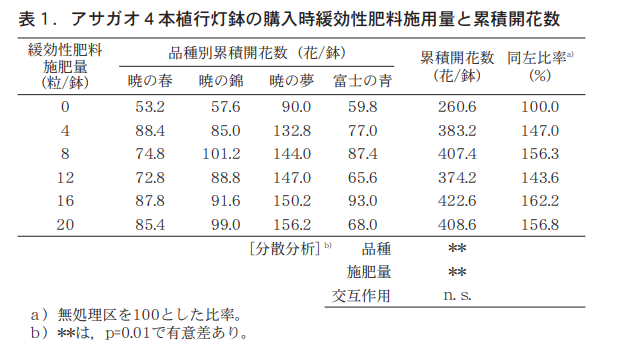

(4) Type and dilution concentration of liquid fertilizer in post-purchase fertilizer management (Experiment 2)
購入後の液肥による追肥効果を花数の推移から検討する。2種の市販液肥①N−P2O5−K2O=20−20−20と②N−P2O5−K2O=10−30−20を用い,①は250,500,1,000,2,000倍,②は125,250,500,1,000,2,000倍と希釈倍率の異なる試験区を設け,水道水のみの無処理区も含めた全10試験区(5鉢/区)で開花数の推移を調査した。なお,液肥の施用頻度は週1回で,灌水は毎日朝1回を原則とした。朝顔まつり2ヵ月後の9月7日までの期間,雨よけハウス内で管理し,つるまきは適宜行い,花数調査後の花は摘花した。9月7日には,成葉葉身部の緑色部3ヵ所の葉緑素値を計測した。
(5) Results of Experiment 2
The cumulative number of blooms during the first two months after purchase of both fertilizer treatments increased with decreasing dilution factor, and the quadratic approximation curve for N concentration for both fertilizers was well fitted, with a peak cumulative number of blooms at approximately 600 ppm (Figure 2).
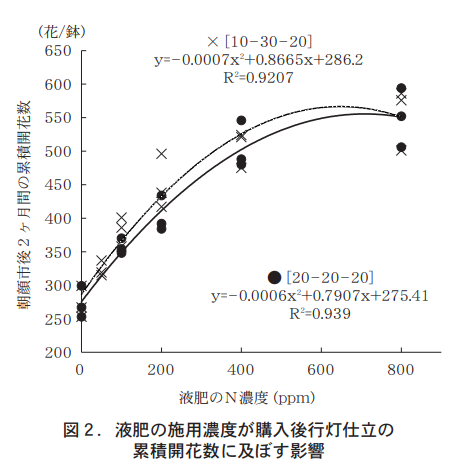
(6) Summary of post-purchase fertilization methods for lantern-shaped morning glory pots
As a result of the above, when a slow-release fertilizer was placed immediately after purchase and a commercial tablet fertilizer with a fertilizing effect of about one month was used, eight tablets per pot (1.5 g/pot for each of the three elements) was the appropriate amount. In the case of liquid fertilizer application, weekly application of [20-20-20] at a dilution of 500 times, N-400 ppm was effective. Considering cost and availability, [20-20-20] is more appropriate than [10-30-20].
鉢花の養分吸収特性に関しては細谷の報告があるが13・14),本試験では,アサガオについて購入後2ヵ月間の長期間にわたる液肥管理を検討し,累積開花数に対して窒素濃度の影響が大きいことを明らかにした。細谷,池田は,植物の生育相および窒素基準の多量要素吸収比から鉢花品目を分類し15・16),須田らはポットマム等主要鉢花について,栽培後半の培養液濃度が日持ちに及ぼす影響を検討している17)。アサガオは,本葉を展開させながら茎が伸長し,開花を連続させることから,シクラメンと同様に長期開花型に含まれ,特に窒素の欠乏が,開花数と葉色を損なう大きな原因であると考えられる。今後,置肥の窒素肥効の持続期間や購入時鉢内に残存する窒素肥効についての検討が必要である。
Trial production of long tailored morning glory pot seedlings using combustible materials (Experiment 3)
(1) Materials and Methods (Experiment 3)
桔梗咲品種「紫獅子」と「紅獅子」を供試した。紙製ポット「トーカンベジポットSA−30−2(外径9.0cm×高さ7.6cm)サンナップ(株) 製)と,ポリポット(PP・PE製黒色 外径9.0cm×高さ7.6cm)のそれぞれに,「もみ殻くん炭(以下くんたん)」 ,椰子殻コンポスト「あく抜きベラボン®1250M(以下ベラボン)」および赤土配合土(赤土:pH調整済みピートモス:腐葉土を容積比5:3:12で配合)を用土として用いた区を設定した。2017年5月1日に200穴セルトレイへ播種し,5月9日には1ポットあた「紫獅子」2株と「紅獅子」1株を寄せ植えで定植した。基肥には市販の緩効性化成肥料(N−P2O5−K2O−MgO=6−40−6−15)3g/Lと微量要素入り被覆燐硝安加里(マイクロロングトータル280−70タイプ)を2g/L施用した。ポット育苗中に伸張したつるは,長さ1.8mのジュートひもへ誘引し長尺仕立てポット苗とした。
After July 8, the last day of the Iriya Morning Glory Festival, the seedlings were displayed outdoors in pots on the south wall of the main building of the Edogawa Branch Office. The seedlings were placed in rows of 10 cm between plants in a rain gutter (TR75 made by Takiron) laid on the ground, and were managed to reach a maximum plant height of 3 m by adding a pulling string. The number of seedlings grown in the greenhouse was at least 7 plants in each plot, and 12 plants were tested when grown outdoors. A 2000-fold dilution of a commercial liquid fertilizer (N-P2O5-K2O=20-20-20) was applied as additional fertilizer during outdoor management. The changes in plant height and flowering position by flower color were investigated by actual measurements and by image determination using a fixed-point camera (Brinno TLC600), which took one-hour interval images from 5:00 to 10:00 every morning.
(2) Combination of growing container and soil and seedling growth (Experiment 3)
For potted seedlings planted on May 9, leaf color (SPAD value) did not differ among containers, but was influenced by the substrate. In particular, the SPAD value of cotyledons on May 21 was significantly lower in Veravon. Even on June 13, when the cotyledons had dropped off, there were significant differences among the soils (Table 2). Grass height was affected by both container and soil on June 13 and June 27, but only by soil and not by container on July 4. Although grass height was inferior in the Veravon area on all survey dates, it increased with the number of growing days, indicating that the growth was good (Table 3). No difference was observed in the date of first flowering among the different containers and soils (data omitted).
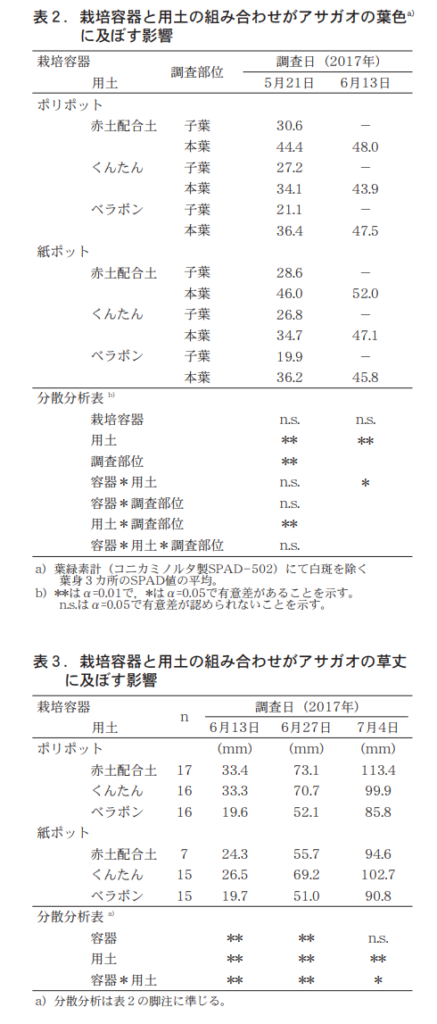
(3) Dry weight of long tailored pot seedlings at completion (Experiment 3)
The flowering of each section of containers and soils was ready, and the outdoor installation was set for July 7, the middle day of the Iriya Morning Glory Festival. The dry matter weight of the long-tailored potted seedlings at the time of shipment was reduced to half that of the conventional combination of polyethylene pots and red soil by using Kuntan and Veravon (Fig. 3).
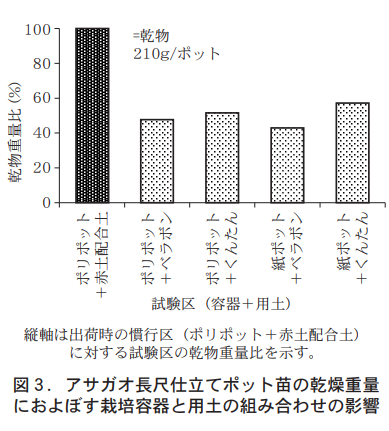
(4) Outdoor placement of long-tailored potted seedlings with combustible materials and the number of daily blooms (Experiment 3)
The number of daily blooms in paper pots made of combustible material in combination with either kuntan or veravon as a substrate was equivalent to that of the conventional material until August 9 (Figure 4).
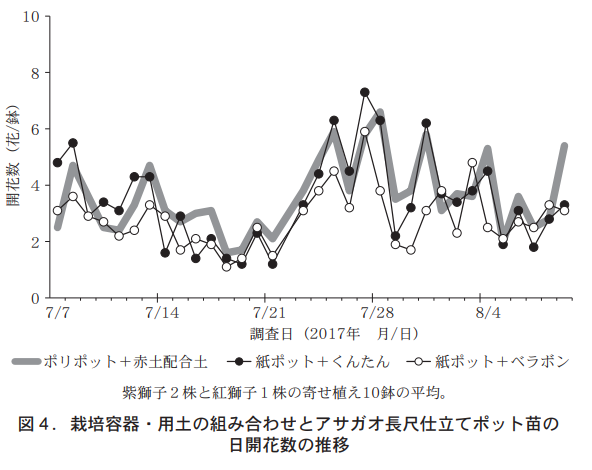
(5) Outdoor management of long tailored potted seedlings using combustible materials and their growth and flowering (Experiment 3)
The plant height of the combination of Kuntan and Bellavon in paper pots on July 26 and August 1 and 10 was similar to that of the conventional polypropylene pots + red soil mixture. The distribution of flowering by height above ground was also similar, but on July 26 and August 1, "Red Lion" tended to flower at relatively low height (less than 1.0 m above ground) and "Purple Lion" at 1.0 m above ground. The flowers were almost uniformly distributed at each height (Fig. 5, Photo 2).
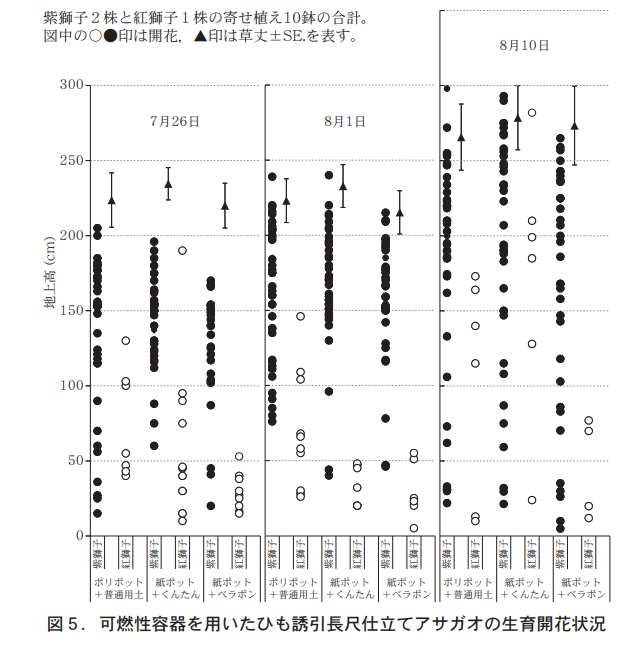
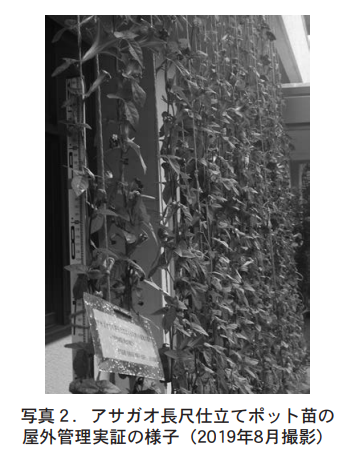
Summary
We focused on the number of blooms during the first two months after purchase of the four-plant, paper-lantern style morning glories, a standard at the Iriya Morning Glory Festival, and investigated fertilization methods after purchase. The results showed that (1) slow-release fertilizer with at least 1.5 g each of the three elements at the time of purchase and (2) weekly application of a liquid fertilizer (N-400 ppm) containing equal amounts of the three elements after purchase were effective.
We also attempted to commercialize long pot seedlings of morning glory induced by string, and proposed a plant decoration that can be disposed of entirely as combustible waste after use by using a combustible cultivation container and soil. The paper pots used as growing containers showed good growth as well as conventional polypropylene pots, and the number of days of flowering was not affected. In addition, by filling the paper pots with kuntan, it was possible to reduce the weight by 50% or more compared to conventional pots, and no effect on growth and flowering was observed.
Some of the results of this research have been used in the production of materials for plant decoration at venues such as the Tokyo 2020 Games, and are already being used at the Asakusa Namiki-dori Avenue in Taito Ward, Tokyo (Photo 3)18). After purchasing morning glories as potted flowers or planting them as plant decorations, it is essential to pay attention to the persistence of nitrogen fertilization. In this respect, slow-acting long-acting fertilizers are highly effective, and it is considered essential to make good use of these fertilizers to improve ornamental value.
*The present results are a summary of Tokyo Agricultural Experiment Station Research Report (32) "Technical Improvement and Post-purchase Management Methods of Gyoran Morning Glory Production for Iriya Morning Glory Market" (2004) and Tokyo Agricultural Experiment Station Research Report (15) "Development of New Plant Decorative Materials by Long-Tailoring Morning Glories" (2020). Part of the research was conducted by the Ministry of Agriculture, Forestry and Fisheries of Japan under the "Commissioned Research and Development of Technology to Enhance the International Competitiveness of Domestic Flowering Plants (FY2015-2019)".
References
1)椎野昌宏.朝顔百科 朝顔園芸世界の過去・現在・未来.
朝顔百科編集委員会編.誠文堂新光社.pp.6(2012)
2)日高薫・丸山伸彦.意匠としての朝顔.伝統の朝顔.
国立歴史民族博物館編.pp.60−61(1999)
3)東京2020大会エンブレム最終候補作品に関するご意見集約レポート.
(公財)東京オリンピック・パラリンピック競技大会組織委員会.
https://tokyo2020.org/jp/games/emblem/archive /data/pub-comments-report.pdf(2016)
(4) Weekly Shiki Hanameguri 42. shogakukan creative. p.4-7 (2003). Shogakukan Creative. p.4-7 (2003)
5) Kawano, Yoshikazu. About Iriya Morning Glory Market. Traditional Morning Glories. National Museum of Japanese History, pp.43-44 (1999)
6)東京の花 第17回日本花き生産者大会記録誌,東京都経済局農林部監修.
東京都花き園芸組合連合会.p.158−159(1968)
7)滝沢昌道.東京都における花き生産の立地と成立条件.
農業経営研究33−1.p.30−39(1995)
8)都市政策の基本的な課題と方向検討小委員会報告.
https://www1.mlit.go.jp:8088/common/000043480.pdf
国土交通省社会資本整備審議会都市計画・歴史的風土分科会都市計画部会報告(2009)
(9) Basic knowledge of wall greening that you should know.
https://urbangreen.or.jp/wp-content/uploads/2015/10/wallgreenerybook.pdf.
都市緑化機構特殊緑化共同研究会(2018)
10)環境共生時代の都市緑化技術 屋上・壁面緑化技術のてびき.
(財)都市緑化技術開発機構編.(1999)
11)渋谷圭助.立体緑化による環境共生.立体緑化のための植物材料の生産.
ソフトサイエンス社.pp.215−220(2005)
12)渋谷圭助ら.屋上・壁面緑化に向けた植物生産技術の開発
−壁面緑化用つる性植物生産技術の開発−.
都農総研セ研究成果情報.pp.97−98(2005)
13) Hosoya, T. and Miura, Y. (eds.) Nutritional Physiology and Fertilization of Flowering Plants. Nutritional physiology and fertilization of flowering plants. Noubunkyo. pp. 28-32 (1995)
14)細谷毅.ポットマムならびに数種鉢物花きの養分吸収経過と施肥に関する研究.
埼玉園試特報1.(1985)
(15) Takeshi Hosoya. Types and Nutrient Absorption of Flowering Plants and Potted Plants, in "Compendium of Agricultural Technology: Flowering Plants", (1993).
16)池田幸弘.花卉の系統(品種)と養分吸収特性 鉢もの,ポット苗.
農業技術大系 花卉編.pp.231−236(1993)
17)須田晃・酒井広蔵・西尾譲一.主要鉢花の栽培後半の培養液濃度が
室内での日持ちに及ぼす影響.園学雑別2,72.pp.227(2003)
18)小川信彦・平林正明.花の心プロジェクト
−江戸ルネサンス伝統と文化が薫るおもてなし−.
グリーン・エイジ543号.pp15−18 (2019)